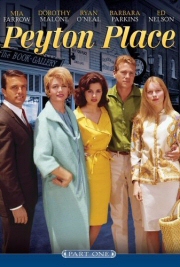- Drama
- 1964
- Buy the DVD
Reviewed by Ross Ruediger
()
t doesn’t take long after putting in the first disc of “Peyton Place” to see that it must have been a huge influence on David Lynch, ultimately taking his imagination down the path that eventually led to “Twin Peaks” (and to a different degree, “Blue Velvet”).
Peyton Place is a town full of secrets. It’s been put on slow boil, ready to erupt at any minute. Its characters’ lives are all so intertwined with one another, it’s amazing that anyone has a secret to keep, but that’s alright, because it’s all the more gripping when the skeletons come tumbling out of the closets. Peyton Place is a small, New England town full of doctors and high school students, the sane and the mentally unhinged, the good, the bad, and all those in between. It even features a mill with a complex family history as a major backdrop, which Lynch perhaps added to his series as an acknowledgement of the town in which the swaying trees and waterfalls of “Twin Peaks” were rooted. If you’ve never watched “Twin Peaks,” my advice would be to go buy the complete series box set, and then come back and watch “Peyton Place.” If, however, you are a “Peaks” devotee, then have I got a series for you (minus, of course, all the Lynchian weirdness like log ladies, giants and dwarfs).
“Peyton Place” was essentially TV’s first primetime soap opera. Based on the hit book and movie of the same name, the series was quite the runaway hit coming out of the gate, and having now seen 31 episodes of it, I understand why. It’s addictive television in a way that only the best soap operas have the power to be.
There are the Harringtons, the rich family who own the mill: father Leslie (Paul Langton), a ruthless businessman; his wife Catherine (Mary Anderson), a strange woman who never seems to leave her bedroom; and their teenage sons Rodney (Ryan O’Neal) and Norman (Christopher Connelly), the former outgoing and well-liked, and the latter withdrawn and socially inept. Then there are the Andersons, a family struggling with finances and steeped in duplicity: father George (Henry Beckman) is a man on the edge; his wife Julie (Kasey Rogers) must summon every last bit of strength to stay with him; and daughter Betty (Barbara Parkins) seems willing to do almost anything to get away from the situation. Although “Peyton Place” really is very much an ensemble drama, the billed stars of the show are single mother and bookshop owner Constance Mackenzie (Dorothy Malone) and her bright, innocent daughter Allison (Mia Farrow). In the first episode, Dr. Michael Rossi (Ed Nelson) moves to Peyton Place to set up practice, and as the series moves forward, it’s through his eyes that the viewer most clearly sees the hypocrisies and problems of the townsfolk.
It’s not that small towns are intrinsically bad places to live, of course, but it would be foolish to expect them to be any more righteous than big cities; wherever people congregate, there’s always bound to be trouble, and “Peyton Place,” like “Twin Peaks” after it, is all about blowing the lid off idyllic small town life. In the final episodes of those presented here, we’re introduced to Elliot Carson (Tim O’Connor, Dr. Huer of “Buck Rogers” fame), a man returning to Peyton Place after 18 years in prison for the murder of his wife. How is Carson connected to Constance and Allison? That answer you’ll discover before the box set finishes up, but as to how Peyton Place treats Carson upon his return, or whether or not he actually did kill his wife – well, you’ll have to wait for the next DVD release to find out those answers.
Some will be drawn to the material for Farrow and O’Neal, who are both so wet behind the ears they can’t possibly stand out amongst the more seasoned actors in the series. At the top of the heap, for this viewer, is Henry Beckman (who might be best known to genre fans as Detective Frank Briggs in the Tooms episodes of “The X-Files”). His George Anderson is an amazing TV creation for ‘64, and it’s something of a marvel to watch him drift through these episodes. Sometimes he’s a drunk, sometimes a wife beater, sometimes a prescription drug addict – and sometimes he’s trying his best to be a good husband and father. But the guy is always desperate, and you genuinely never know what dark path he’ll go down next, or how remorseful and pitiful he’ll be the next day. Beckman must have had to find the really shady places within to play the part, but the show is all the better for it. Not terribly far behind him is Parkins, who plays his daughter Betty. Looking an awful lot like Sarah Michelle Gellar with a black wig, she represents the sinister side of youth, and while it’s almost impossible to ever really root for Betty, you always understand exactly why she does the questionable things she does, and it’s difficult to argue against her logic. Really, though, there isn’t a bad performance on the show, and I’ve only mentioned about half of the well drawn characters you’ll meet along the way.
Although it moved to color in later seasons, at this early stage the show is gorgeously shot in black and white. I dread the eventual switch to color, because the mood is so perfectly set and the story so ideally served by the photography. “Peyton Place” is not nearly as naïve as you’d think a show from 1964 might be. Thematically, most of the topics it covers remain if not relevant, at least believable nearly 45 years later. Despite only being on the air for five seasons, the show racked up a whopping 514 episodes. Given that this set consists of 31 half hour installments, that means roughly 15 or 16 more sets are going to have to be released in order to complete the series, which is brought up only to prepare you for the amount of time and money you may be spending over the long haul if this set hits you anything like it hit me.
Shout! Factory hasn’t had a decent track record as of late, especially with fare like “Room 222” and “Rhoda,” both of which had first season releases with questionable transfers. This is noteworthy, because once upon a time Shout! was the mark of quality on a TV-on-DVD release. (Remember their excellent “Freaks and Geeks” and “My So-Called Life” sets, for instance?) I was delighted to find that “Peyton Place” bucked the recent trend – at least at first. Disc One is more than watchable – while the transfers didn’t appear to have any work put into them, they also weren’t at all unacceptable given the age of material. I was a very happy DVD camper. Then along came Episode 7 on Disc Two, at which point the picture became rather dark and murky (and may even have been missing a minute or two). But I moved ahead and found that, while there were some other episodes that were not up to par, for the most part, the episodes matched what was on the first disc. Further – and whether or not it was due to the show being in black and white (as I’ve become accepting of B & W not always looking stellar over the years), or because the storytelling was just so damn engaging – I ceased to care about the quality. I was, quite simply, grateful to bask in this series that for years I’d heard about, but had never experienced. The video (and sometimes the audio) quality of this set is not always ideal, but the show itself most certainly is, and hopefully that will be enough to carry you though from episode to episode, as it was for me. Please, Shout!, keep it up and bring us all of “Peyton Place.”
Special Features: There are no extras on this set whatsoever, but “Part Two” is already set for release in mid-July, and if people keep buying these sets, who knows what could happen? Are you listening, Shout!? The presentation is the only thing keeping this from being a full-on five star review. As Dale Cooper might say, this show is a “damn fine cup of coffee!”
You can follow us on Twitter and Facebook for content updates. Also, sign up for our email list for weekly updates and check us out on Google+ as well.













